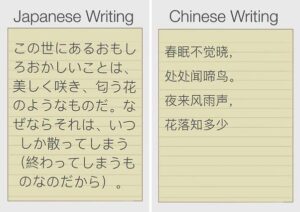

Collectively, there are over 1.2 billion Chinese and Japanese speakers worldwide. It is only reasonable that there is such an astronomical number of Chinese vs Japanese speakers because they are both ancient languages.
These languages have some similarities but it is also vital to note the differences between the Chinese and Japanese languages to avoid any confusion, whether in business or personal interaction.
Professional translation services can easily spot the differences in the two languages because they have to process various legal documents; however, it may be challenging for someone who hasn’t dealt with the languages before.
To assist you in this endeavor here is an easy way to tell the similarities and differences between the two languages:
Behind the Confusion
It is understandable why so many people get confused when Chinese vs Japanese writing comes up because these languages have many similarities. These similarities are noticeable to native speakers, but to foreigners, it is a different case. Some of the common similarities include:
1. Similar writing systems
Both Chinese and Japanese languages have multiple characters in common. Known as the Hanzi in Chinese, and Kanji in Japanese, these two languages share more than half of the characters. Through cultural intermingling, experts believe that Japan assimilated China’s writing system and molded it to fit into their culture.
As years passed the Japanese fully developed their version, and the Chinese also assimilated the newer Kanji into their language.
2. All about the numbers
Many ancient languages possess unique numbering systems, including the Chinese and Japanese. These languages’ number writing structure is the same; hence, it looks like the same language when presented in writing.
However, those with a keen eye may tell the difference between Chinese and Japanese writing through the shape of the characters. Chinese characters are squarer-shaped while Japanese characters are curvier.
3. Absence of plural forms and grammatical genders
In the past, Chinese and Japanese languages did not have nouns or adjectives that conformed to match the subject’s gender. They used the same word to address both genders and to date, there have been minimal changes in this regard.
Apart from lacking grammatical gender, both these languages do not have plural forms. They mostly have one plural form or a number to denote the quantity of a noun. You have to understand the quantity of something through the context of the message.
4. Appellations
There is an emphasis on observing titles when it comes to Chinese and Japanese culture in both writing and speech. Both societies respect the hierarchy structure to avoid disrespect; therefore, it is rare to find people referring to each other by their first name, unless in informal situations. Titles such as doctor, chairman, teacher, farmer, among others will proceed before the individual’s first name.
Dissipating the Confusion
Now that you understand the similarities, let’s tackle the obvious differences between Chinese and Japanese writing or speech.
1. Grammatical variations
In the Chinese vs Japanese language battle of differences, the first difference is that they have different grammatical structures. People find Chinese grammar easier to grasp because it only features Hanzi characters. Verbs in the Chinese language only have one form and therefore, conjugation is out of the subject.
Japanese grammar is more complex because of the hiragana writing system, which permits conjugation variations and particles. In addition, the sentence structure order is different as it follows the subject, object, and verb pattern; while in the Chinese language, the subject, verb, and object pattern reigns.
2. Difference in tone
Tone is crucial in the Chinese culture because different intonations pass on different messages. For example, ma could mean a horse, mother, or hemp, depending on the pronunciation or emphasized syllable.
The Japanese language is more simplistic consisting of consonants, vowels, and syllables all in the same length. It does not mean that the Japanese lack tonal language, but theirs is easily recognizable when written and the instances of occurrence are fewer compared to Chinese
3. Writing system variations
Another difference between the two languages is the number of writing systems included. The Japanese language is ahead in this aspect because it has three writing systems including Hiragana, Kanji, and Katakana. Kanji is more challenging to master but Hiragana and Katakana are more manageable.
The Hiragana system fills the particles needed in between the Kanji for grammatical correctness. Katakana typically denotes borrowed names and words from foreign languages like the word “Starbucks” from English.
In contrast, the Chinese language only has one written system ingrained in their Hanzi. Nowadays there is a simpler version of written Chinese promoted since 1949 by the government to encourage more literacy.
4. Reading contrasts
The Chinese Hanzi characters are simpler to read because there are few possibilities in what a certain character could mean. Japan’s Kanji may be similar to Hanzi but the probability of interpreting one character in several words is high. Although Kanji is similar to Hanzi, there is a significant difference in the number of ways the same character can be read.
5. Observing politeness
The Japanese culture presents various forms of politeness in grammar to suit the occasion. Keigo, polite forms of speech, vary depending on the level of formality. The three categories of Keigo include the honorific, humble and polite form. The Chinese language does feature polite language but it is not as detailed as the Japanese language.
Maneuvering Around These Differences
Clearly distinguishing between the two languages is advantageous on a global scale because China and Japan are both economic powerhouses. Businesses and other services rely on language translation services to ensure both legal and personal documents get the right translation whether in Chinese or Japanese.
Even from remote areas of the world, it is possible to access online translation services as long as internet access is available. If you are not fluent in any of the languages, professional translation services are a viable solution, especially when handling legal documents. Save yourself the trouble of having to learn the languages from scratch and hire a professional to do it at an affordable rate.
















